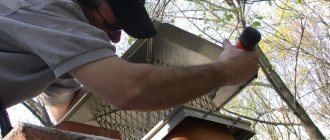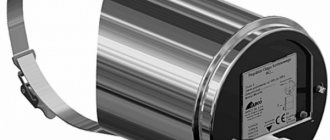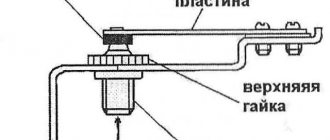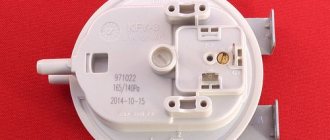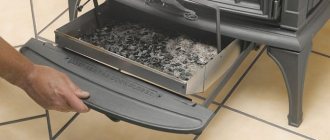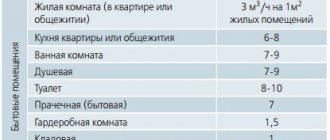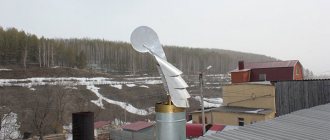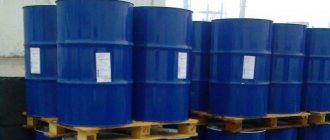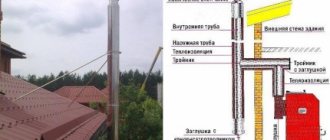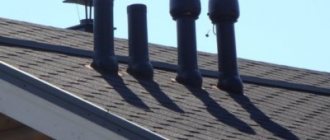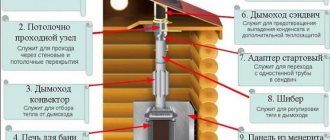Craving as a physical phenomenon
- When there is no artificial ventilation (let’s mentally turn to natural conditions, as everything happens in nature), air masses behave as follows:
- air by default tends to where it encounters the least resistance;
- as soon as aerodynamic “help” appears in the form of an elongated “corridor”, the intensity of air flow increases. They are forced to move to where an empty, unoccupied place awaits them.
- As a matter of fact, chimneys and pipes serve precisely as such corridors. This is a man-made option to forcibly create draft to extract combustion products from the premises:
- as a result of certain engineering calculations, the pipe of a furnace, column or boiler has such characteristics as to create an aerodynamic directed air flow of flue gases;
- draft occurs due to the fact that the air pressure inside and outside the furnace is different.
Violation of draft is not a consequence of poor quality chimney.
Reverse airflow can occur even when using prestigious equipment. In this article you can learn about the pros and cons of a homemade long-burning wood-burning stove. Find out how to independently build stoves for a wood-burning cottage here. Read about the advantages and design features of a brick stove with a water circuit:
Backdraft Detection
To denote the reverse movement of air flows (not through the chimney, but back into the room), there is a term - overturning the draft. The name speaks for itself: the flow of gases from burning fuel tends back into the room, and not out. There are many videos about this on the Internet with detailed descriptions.
Before each start of heating devices, it is recommended to determine the strength and direction of draft with the ventilation devices turned off (if any are installed).
Traditional methods
- We’ll talk about the factors and reasons below, but now let’s figure out what needs to be done in order to identify the very fact of the thrust overturning:
- if the firebox has a glass door (for example, such an element is found quite often in fireplaces), you can clearly see through the glass how quickly it smokes. One has only to open the door slightly, and a cloud of smoke immediately rushes out, that is, into the room;
- It is enough to attach a sheet of thin paper to the opening of the open firebox and see in which direction it deviates. A smoking cigarette instead of a piece of paper will show the same thing.
Professional methods
There is measuring equipment that allows you to measure the draft in the chimney with maximum accuracy, in pressure units. Indicators within 10-20 Pa are considered normal.
- Measurements are made using a two-way method:
- at the top of the chimney;
- at its base.
However, this technique is hardly relevant for a private home - most people make do with traditional visual methods.
The anemometer does not provide objective information at wind speeds below 1 m/sec. That is, in calm weather there is no point in using such a device.
Visual cues
- If the ratio of combustion and draft processes is normal, then:
- the flame is yellow with a golden tint;
- smoke appears and immediately evaporates into the chimney channel - without jerking, smoothly and at the same time energetically.
A situation where the normal thrust is too high is not good, because the fuel will burn out too quickly. Excessive draft will be indicated by the white color of the flame and the roar in the chimney.
What affects cravings?
The size of the chimney is influenced by many factors. The most important among them are the height and cross-section of the chimney channel. These two parameters are always interrelated and depend on the characteristics of the stove or fireplace. Their calculation requires extreme vigilance, since in case of error the thrust will be poor. And this will lead either to the reverse movement of carbon monoxide or to excessive burning of wood.
Today there are entire tables that will allow you to make the correct calculation of the size of smoke channels . For example, in order to create adequate draft in a fireplace, you need to make sure that the exhaust duct has a cross-section that is less than 1/10 of the area of the firebox inlet. It seems that if you increase the cross-section of the exhaust duct , then the draft should increase. However, on the contrary, it will decrease, because the smoke will come out more slowly. Because of this, it will cool and accumulate in the outlet pipe. What's not good. Therefore, specialists make a lengthy calculation to determine the correct cross-section .
Why does backdraft occur?
Of the reasons and factors why traction goes in reverse, the most common ones should be highlighted. In turn, they can be divided into simple (temporary, easily removable) and complex (requiring drastic intervention).
Complex reasons
- Most often it's this:
- structural defects of the chimney system (the presence of horizontal or too narrow sections in the chimney, incorrect calculation of the cross-section of the pipe, the height of the pipe is below the level of the ridge of the roof of the house) - engineering deficiencies must be eliminated;
- clogging of the smoke exhaust channel - you will have to clean it out;
- Trees growing too tall near a residential building or high-rise buildings are located - the issue of redesigning the entire chimney system needs to be resolved;
- errors when installing indoor ventilation (insufficient supply air) - accordingly, ventilation diagnostics, dismantling and reinstallation will be required.
Simple reasons
There are times when the thrust “overturns” for just a couple of days, although before that everything worked fine.
Reverse thrust occurs due to the fact that:
- cool weather set in;
- the firebox or stove has been idle for a long time and is not working.
How is this physical phenomenon explained? Very simple:
- a fair amount of heavy cold air has accumulated in the chimney;
- the cooled air mass will be the very obstacle that the air does not like to overcome (see the beginning of the article - the correct draft is always directed to where there are no obstacles).
Solution to the problem:
- endure the smoke in the room and continue heating the pipe - soon the cold “cushion” will be broken through and the draft will be restored. Burn 3-4 sheets of paper without firewood - there won’t be much smoke, and the chimney will warm up;
- use a device called a traction stabilizer in such situations. With its help, the secondary air supply will accelerate the movement of air in the chimney.
The stabilizer is equipped with a safety valve that prevents excessive pressure build-up.
Efficient traction process
A certain difference appears if the air temperature outside and inside the room have different indicators. And the greater this difference, the more powerfully the air masses from the room rise upward. If it is warm enough outside, the draft decreases, and the effectiveness of ventilation itself decreases. In addition, the draft intensity is influenced by the parameters of the pipe cross-section and the dimensions of the ventilation ducts.
It is worth noting that designing and carrying out appropriate calculations for the ventilation system must be done at the initial stages. It is almost impossible to make corrections during the work process. Experts say that rooms that are approximately at the same level must have the same length of ventilation ducts, otherwise the efficiency of the entire system may drop sharply.
There are the following features for choosing ventilation pipe parameters:
- the cross-section of the channel must be at least 16 cm 2 if the pipe is made of stainless steel;
- the side of the channel must be at least 10 cm, and the most common option is 14 cm. In this case, its length will be approximately 3 m;
- If it is impossible to create the same length of channels, ventilation grilles are used for all rooms of the building.
If the calculations are carried out correctly, then you will see why a ventilation pipe is needed in every house. It will supply fresh air and remove polluted air up to three times in just one hour.
Regardless of the type of ventilation systems, special flow grilles are installed to ensure unhindered movement of air masses throughout the building. With proper organization of air flow, the dirtiest room will be ventilated last. In accordance with this principle, the hood is installed in the toilet or kitchen.
Reverse draft and ventilation
- No one has canceled the natural laws of ventilation:
- Warm air has a much lower density than cold air;
- therefore, warm air tends to rise;
- if somewhere inside the house windows or doors are open to the street with cool weather, when the heating devices are turned on, the air will go there, and not into the chimney (as the user would like).
Ventilation force during air outflow
- The internal architecture of the building is of great importance:
- if the house has many windows, there are balcony doors or stairs to the upper floor - all this will lead to the formation of drafts;
- On areas located above the firebox level, opening windows and doors to the street is not recommended.
Failure to follow such simple tips is a guarantee that air currents that disrupt the draft will be formed.
Providing ventilation with supply air
- Sometimes the following happens:
- the room is sealed (doors are locked, windows are closed);
- when the stove is lit or the gas boiler or water heater is turned on, low-pressure areas draw fresh air from the chimney;
- result - the thrust overturns;
- The solution suggests itself - it is necessary to create the required air circulation. What needs to be done for these purposes:
- install wall supply valves;
- install supply valves on PVC windows;
- place a forced ventilation device on the window to draw air masses from the street into the room (such devices cut directly into the window glass - you can watch the video on the Internet to see how to make the insert);
- slightly open the window, door or window.
The implementation of one of these measures will lead to the fact that the atmospheric pressure in the room will decrease and the reverse draft will disappear.
If there is a gas water heater
- A gas-powered dispenser has a number of features:
- its combustion chamber draws air out of the room;
- the lack of oxygen becomes noticeable quite quickly (the air becomes thinner, oxygen deficiency is felt);
- Air will periodically penetrate from the chimney, which will lead to the fading of the column and smoke in the room.
Sometimes the user rushes around looking for a defect in the gas water heater instead of carefully analyzing the ventilation - its consistency and efficiency.
Chimney cross-section and height
The cross-section of the chimney is a parameter that determines the size of its clearance. For rectangular and square chimneys, the cross-sectional area matters, and for round and oval chimneys, its diameter matters.
In a narrow pipe, the air creates turbulent flows and, instead of going out, travels through the pipe for a long time. The longer the warm gas is forced into the cold walls of the pipe, the colder it becomes. Cold smoke will not come out of the chimney. In a chimney that is too wide, there is also the possibility that the smoke will cool quickly due to the excessive intake of cold air.
The optimal chimney area is considered to be at least 10 cm2, in the case of a round pipe - a diameter of at least 15 cm. When installing fireplaces in which the combustion temperature of the fuel is slightly higher than in stoves and columns, you should focus on a minimum diameter of 10 cm. The maximum diameter will be depend on the size of the heater.
It is important! The pipe should not have narrowings or bends, otherwise the draft will be significantly reduced.
As for the height of the chimney, it depends on many parameters. Under ideal conditions, when the roof is level, has no protrusions, there are no trees or other buildings at its level, and nothing blocks the air access to the chimney, the chimney has a maximum height of 5m. In this case, its height is calculated from the heater grate to the very top.
We recommend that you read: What is a vent pipe and is it needed in a private home?
The height of the pipe above the roof level under the same conditions is 1.5 m.
Smooth roofs are very rare in houses. They are often sloping, have various fencing or decorative elements, and come into contact with trees and other buildings.
Under all these conditions, the height of the chimney is calculated separately.
Ways to normalize cravings
To summarize, let's once again clarify how to increase weak traction and prevent it from tipping over. The choice of method depends on the reasons for the disruption of air flow. Sometimes it is recommended to use more than one method - consult with professionals so as not to make even more mistakes.
Structural changes to the chimney
- It was noted just above that the chimney can be done incorrectly:
- the top edge of the pipe is too low;
- narrowed passages;
- a lot of unnecessary bends, etc.
Such defects must be eliminated.
Stabilizing devices
A reliable chimney draft stabilizer is one of the most effective solutions. Modern devices are equipped with automation. It is enough to turn on the device when problems arise in the chimney with the direction and strength of air flows. As soon as the pressure level reaches the optimal level, the device turns itself off.
- This device makes a significant contribution to improving traction:
- we are talking about an umbrella-shaped extension on the chimney;
- under the umbrella there is an open area for access of air from outside;
- under the umbrella cover there is a temperature sensor for recording the temperature of rising gases from the firebox or column;
- the sensor automatically turns off due to overheating due to gases accumulated due to poor draft.
Deflectors
The purpose of these devices is to increase traction by deflecting air flows. The operating principle is based on the fact that when air flows over obstacles, pressure decreases. The disadvantage of the products is almost zero efficiency in calm weather. If there is no wind outside, the deflector is not only useless, but can also worsen traction.
Rotary pipes
A turbine is installed above the chimney head.
Wind energy rotates the turbine head. Rotation always occurs in one direction - due to this, a vacuum is created above the smoke channel. Unfortunately, in calm weather the effectiveness of the rotary tube is minimal. But the entry of debris and sediment into the chimney is almost completely eliminated. A video with step-by-step instructions will help you understand all the intricacies of this method.
An additional advantage of rotary pipes: the turbine continues to operate even when the heating is turned off.
Revision of the ventilation system
- In most cases, it is enough to analyze the ventilation in the house and thereby eliminate the reverse draft. As noted above, you should carefully:
- regulate the formation of drafts;
- do not allow rarefaction of air in the heated room;
- if necessary, install ventilation devices on the windows.
Never forget: the thrust should not reverse. If there is a strong rollover, there is a threat of not only smoke in the room, but also the release of sparks with subsequent ignition of surrounding objects. If you have any difficulties, invite an experienced specialist to solve the problem with traction.
